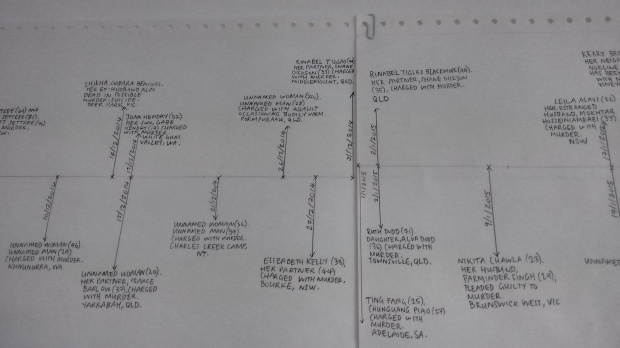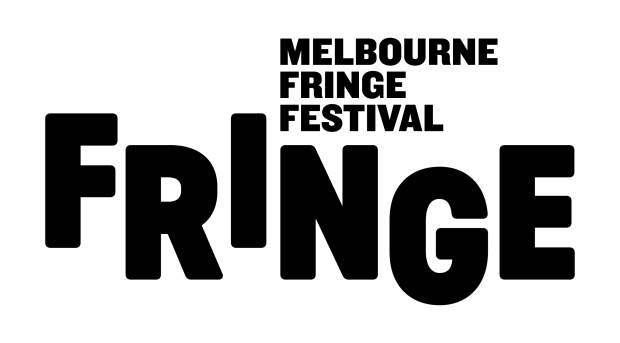I don’t know much about artist Emily Dang, but I did recently have the privileged of viewing some of her art at the Monash University MADA Graduate Exhibition. Documenting Australian women killed by violence, 2016 is a thought provoking piece. Utilising data collected by the Counting Dead Women project run by Destroy the Joint, Dang created a time line on tracker feed paper using graphite pencil that documents the details of each women killed by violence from 2014, including the charges made in relation to the killing. The three plus metres of documented violence is sobering stuff.

Portion of Documenting Australian women killed by Violence by Emily Dang, 2016. Photograph by E. Rebecca Sanders
While the stark simplicity of Dang’s time line is confronting in its own right, what really makes this artwork is resonate is Dang’s selection of audio material. Walking in the Woods and I Will Not consist of sound bites from politicians, police, media interviews and popular culture combined to create an aural patchwork that speaks about Dang’s perception of the position of women in Australian society today. Australia’s first female Prime Minister, Julia Gillard, is heard giving her ‘misogyny‘ speech and there are also sections from an interview with the first female Aboriginal minister to sit in any Australian parliament, Marion Scrymgour. In contrast to these female voices are those of former Prime Minster and and self-identified conservative white adult male, John Winston Howard as well as Homicide Squad Detective Inspector Michael Hughes, who made headlines earlier this year with his comments that women shouldn’t be alone in parks. Dang’s contrasting of ‘strong’ women and ‘conservative’ men gives her time line of violence against women a very particular context. One the one hand, Dang’s work suggests that it is possible for women to achieve more than they ever have before, even if they have to fight for their positions, or in Ms Gillard’s case, fight to maintain them. On the other, Dang points out that conservative men are actively discouraging women from risk taking, and that women still feel unsafe in our society and are frustrated by feelings and perceptions of helplessness. The disjunct between these two positions is vast, and throws up a lot of questions about the nature of violence against women in the present era. This is a piece that asks us to question our assumptions about the position of women in current-day Australian society, and to assume a position within this important debate.
One of the more subtle commentaries contained within Dang’s art is the nature of the debate about violence against women. Dang’s use of tracker paper can be read as a reference to old fashioned times and values, and her decision to pencil in victim and crime details is suggestive of the ordinary, banal or everyday nature of violence against women in our society, although it could also be viewed as a commentary about the lack of importance with which this issue has been treated over time. These victims’ names aren’t etched in stone: there’s an impermanence about Dang’s materials that can either be read as throwaway; that such issues are not being given the long term attention they deserve, or more positively, with the hope that we won’t require stone monuments and brass plaques to make important changes to our society.
Emily Dang’s Australian women killed by violence was on show as part of the MADA now 16 Graduate Exhibition from 18 November 2016 to 2 December at Monash University Art, Design & Architecture, 900 Dandenong Rd Caulfield East, Victoria, Australia.
Full details here
 History Creative is proud to be part of this year’s Melbourne Fringe Festival. Fringe is all about independance and difference and I can’t think of a better way to present a slightly different history offering: a walk on the history of women’s public toilets in Melbourne. That’s right, on this tour you’ll be visiting a host of public conveniences and picking up some facinating feminst history along the way.
History Creative is proud to be part of this year’s Melbourne Fringe Festival. Fringe is all about independance and difference and I can’t think of a better way to present a slightly different history offering: a walk on the history of women’s public toilets in Melbourne. That’s right, on this tour you’ll be visiting a host of public conveniences and picking up some facinating feminst history along the way.